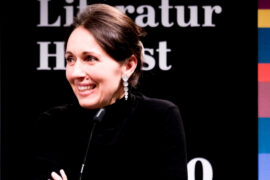40 degrees in the summer, 20 degrees on New Year’s Eve – with rising temperaturs comes climate anxiety, especially for young people. Psychologist Amelie Schomburg spoke about her book Klimaangst with climate activist Thao My Nguyen at the Literaturhaus Göttingen.
By Tripti Sharma
Picture: Tripti Sharma
On January 26, Amelie Schomburg, a psychologist, presented her debut book Klimaangst at the Literaturhaus Göttingen. Talking of the climate crisis and its effects without the presence of a climate activist is of no significance. Thus, Thao My Nguyen, a master’s student and climate activist, studying at the University of Göttingen, was invited as a special guest to express her opinions on climate change and its impact on the mental health of Gen Z. The evening was moderated by Leon-Fabian Caspari, who is a member of the Enlight network. Enlight aims to solve complex issues of climate and sustainability across Europe in intercultural teams.
On this night, the audience was excited to learn about the development and research on the hot topic »Klimaangst« which can be translated into English as climate anxiety. People were curious to know the definition of this new word that arises from the ambiguities of climate change. However, the opening note of Amelie Schomburg left most of them disappointed as there is no exact definition for this word. As a psychologist, she could only express that Klimaangst is a subjective term. It is only felt by people who deal with the climate crisis emotionally and empathetically. Klimaangst is not a disease but rather a state of mind. Therefore, this topic awaits extensive research in the contemporary era.
Promises of the book
The climate crisis is here to stay. It has been more than a decade since the world began dealing with the conspicuous challenges of climate change. Climate change is not only posing threats to our environment but also to our mental health. There are climate activists across the world to raise awareness about climate change’s consequences. But when they fail to transform traditional practices and conservative mindsets, they feel helpless. It becomes difficult for them to see the carelessness among people toward the environment. For them, things are falling apart. They are filled with guilt because they can only see a degrading future. The negative thoughts overwhelm the young population. This is where the book comes on. Klimaangst is a book that discusses the impact of climate on the body and especially mental well-being. Sometimes changes in climate deteriorate the psychological health of a person. This even threatens the existence of a person. Therefore, the book entails strategies for coping mechanisms. Klimaangst teaches people to deal with the emotions arising due to the climate crisis. There are tips, tricks, and tools to divert human emotions.
According to Amelie Schomburg, it is important to learn which part of the body feels fear and anxiety to be able to divert negative thoughts. After this, a psychologist decides upon a suitable tool to convert the feeling of uneasiness into calmness. In general, a productive task assists in channelizing the energy from anger caused by the climate crisis. The energy can be used to do something creative. A person can paint the horrors of climate change, graffiti, or write a social media post. This way, people are conveying their feelings toward a subject to the world. They are being active by using the energy from their anger here and not using the established traditional way of blocking the roads and endangering their lives. One suggestion is to use the outrageous energy to write a ground-breaking book on this matter to raise awareness among people, the way Amelie Schomburg did with her co-author Friederike Schomburg. Thus, the authors of Klimaangst aim to propose that it is crucial to learn from the feeling of annoyance instead of deteriorating one’s mental state. Amelie Schomburg suggests in her book that people do not to leave their focus from the subject but focus on something that does not cause mental problems.
What is next after Klimaangst?
Right now, psychologists are dealing with the problem of Klimaangst, however, there are possibilities for the rise of Klimahoffnung. But who knows what problems Klimahoffnung brings with it as the past follows you like a shadow. Similarly, the impacts of the climate crisis will not diminish. The case of Lützerath in Germany shows that the climate crisis will hardly disappear and so is the case with Klimaangst.
Climate crisis is not coming to an end anytime soon. Therefore, this book is the best fit for all people dealing with anxiety issues from climate change. To motivate, the author of Klimaangst builds and provides real-time tips from interviews with climate activists like Leonie Bremer. The interviews have pieces of advice on how activists build their mental strength. It is better to look after your mental health or consult a psychologist if you are anxious about the climate crisis, otherwise Klimaangst soon can turn into a disease or a pandemic.






